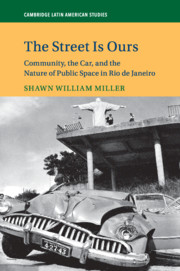Book contents
- The Street Is Ours
- Cambridge Latin American Studies
- The Street Is Ours
- Copyright page
- Dedication
- Contents
- Maps and Figures
- Acknowledgments
- Introduction A Common Space to Enjoy
- 1 Systems Circulatory before the Wheel
- 2 The Street’s Apotheosis
- 3 Putting the Car in Carnival
- 4 Death by Blunt Instrument
- 5 Law and the Promises of Safety
- 6 Buyers and Regrets
- 7 Traffic Flow versus Free Parking
- Conclusion Revolutions at the End of the Street
- Bibliography
- Index
- Other Books in the Series (continued from page ii)
3 - Putting the Car in Carnival
Avenida Rio Branco
Published online by Cambridge University Press: 30 July 2018
- The Street Is Ours
- Cambridge Latin American Studies
- The Street Is Ours
- Copyright page
- Dedication
- Contents
- Maps and Figures
- Acknowledgments
- Introduction A Common Space to Enjoy
- 1 Systems Circulatory before the Wheel
- 2 The Street’s Apotheosis
- 3 Putting the Car in Carnival
- 4 Death by Blunt Instrument
- 5 Law and the Promises of Safety
- 6 Buyers and Regrets
- 7 Traffic Flow versus Free Parking
- Conclusion Revolutions at the End of the Street
- Bibliography
- Index
- Other Books in the Series (continued from page ii)
Summary
- Type
- Chapter
- Information
- The Street Is OursCommunity, the Car, and the Nature of Public Space in Rio de Janeiro, pp. 102 - 148Publisher: Cambridge University PressPrint publication year: 2018



